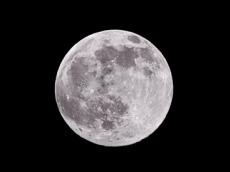|
|
TODAY.AZ / Weird / Interesting
Does the Moon rotate?
05 May 2014 [15:35] - TODAY.AZ
 Attentive observers on Earth might notice that the moon essentially keeps the same side facing our planet as it passes through its orbit. This may lead to the question, does the moon rotate? The answer is yes, though it may seem contrary to what our eyes observe.
Attentive observers on Earth might notice that the moon essentially keeps the same side facing our planet as it passes through its orbit. This may lead to the question, does the moon rotate? The answer is yes, though it may seem contrary to what our eyes observe.The 'dark' side of the moon
The moon orbits the Earth once every 27.322 days. It also takes approximately 27 days for the moon to rotate once on its axis. As a result, the moon does not seem to be spinning but appears to observers from Earth to be keeping almost perfectly still. Scientists call this sychronous rotation.
The side of the moon that perpetually faces Earth is known as the near side. The opposite or "back" side is the far side. Sometimes the far side is called the dark side of the moon, but this is inaccurate. When the moon is between the Earth and the sun, during the new moon phase, the back side of the moon is bathed in daylight.
The orbit and the rotation aren't perfectly matched, however. The moon travels around the Earth in an elliptical orbit, a slightly stretched-out circle. When the moon is closest to Earth, its rotation is slower than its journey through space, allowing observers to see an additional 8 degrees on the eastern side. When the moon is farthest, the rotation is faster, so an additional 8 degrees are visible on the western side. [The Moon: 10 Surprising Lunar Facts]
If you could journey around to the far side of the moon as the Apollo 8 astronauts once did, you would see a very different surface from the one you are accostomed to viewing. While the near side of the moon is smoothed by maria — large dark plains created by solidified lava flows — and light lunar highlands, the far side is heavily cratered.
The rotational period of the moon wasn't always equal to its orbit around the planet. Just like the gravity of the moon affects ocean tides on the Earth, gravity from Earth affects the moon. But because the moon lacks an ocean, Earth pulls on its crust, creating a tidal bulge at the line that points toward Earth. [Infographic: Inside Earth's Moon]
Gravity from Earth pulls on the closest tidal bulge, trying to keep it aligned. This creates tidal friction that slows the moon's rotation. Over time, the rotation was slowed enough that the moon's orbit and rotation matched, and the same face became tidally locked, forever pointed toward Earth.
The moon is not the only satellite to suffer friction with its parent planet. Many other large moons in the solar system are tidally locked with their partner. Of the larger moons, only Saturn's moon Hyperion, which tumbles chaotically and interacts with other moons, is not tidally synchronized.
The situation is not limited to large planets. The dwarf planet Pluto is tidally locked to its moon Charon, which is almost as large as the former planet.
Earth (and other planets) do not escape completely unscathed. Just as the Earth exerts friction on the spin of the moon, the moon also exerts friction on the rotation of the Earth. As such, the length of day increases a few milliseconds every century.
/Space.Com/
URL: http://www.today.az/news/interesting/133318.html
 Print version
Print version
Views: 2850
Connect with us. Get latest news and updates.
See Also
- 19 February 2025 [22:20]
Visa and Mastercard can return to Russia, but with restrictions - 05 February 2025 [19:41]
Japan plans to negotiate with Trump to increase LNG imports from United States - 23 January 2025 [23:20]
Dubai once again named cleanest city in the world - 06 December 2024 [22:20]
Are scented candles harmful to health? - 23 November 2024 [14:11]
Magnitude 4.5 earthquake hits Azerbaijan's Lachin - 20 November 2024 [23:30]
Launch vehicle with prototype of Starship made its sixth test flight - 27 October 2024 [09:00]
Fuel prices expected to rise in Sweden - 24 October 2024 [19:14]
Turkiye strikes terror targets in Iraq and Syria - 23 October 2024 [23:46]
Kazakhstan supplied almost entire volume of oil planned for 2024 to Germany in 9 months - 23 October 2024 [22:17]
Taiwan reported passage of Chinese Navy aircraft carrier near island
Most Popular
 Germany’s Merz visits India to boost trade, security and labour ties
Germany’s Merz visits India to boost trade, security and labour ties
 Terrorist Vladimir Solovyov threatens Armenia and Central Asian countries with war
Terrorist Vladimir Solovyov threatens Armenia and Central Asian countries with war
 UK to spend £200 mln preparing troops for possible deployment in Ukraine after war
UK to spend £200 mln preparing troops for possible deployment in Ukraine after war
 Azerbaijan reaffirms support for Somalia’s sovereignty at OIC emergency meeting
Azerbaijan reaffirms support for Somalia’s sovereignty at OIC emergency meeting
 Ukraine releases footage of night drone strikes on Caspian Sea oil platforms
Ukraine releases footage of night drone strikes on Caspian Sea oil platforms
 Baku Slavic University prepares to commemorate its 80th anniversary
Baku Slavic University prepares to commemorate its 80th anniversary
 Israel raises alert level as US discusses possible role in Iran unrest
Israel raises alert level as US discusses possible role in Iran unrest
